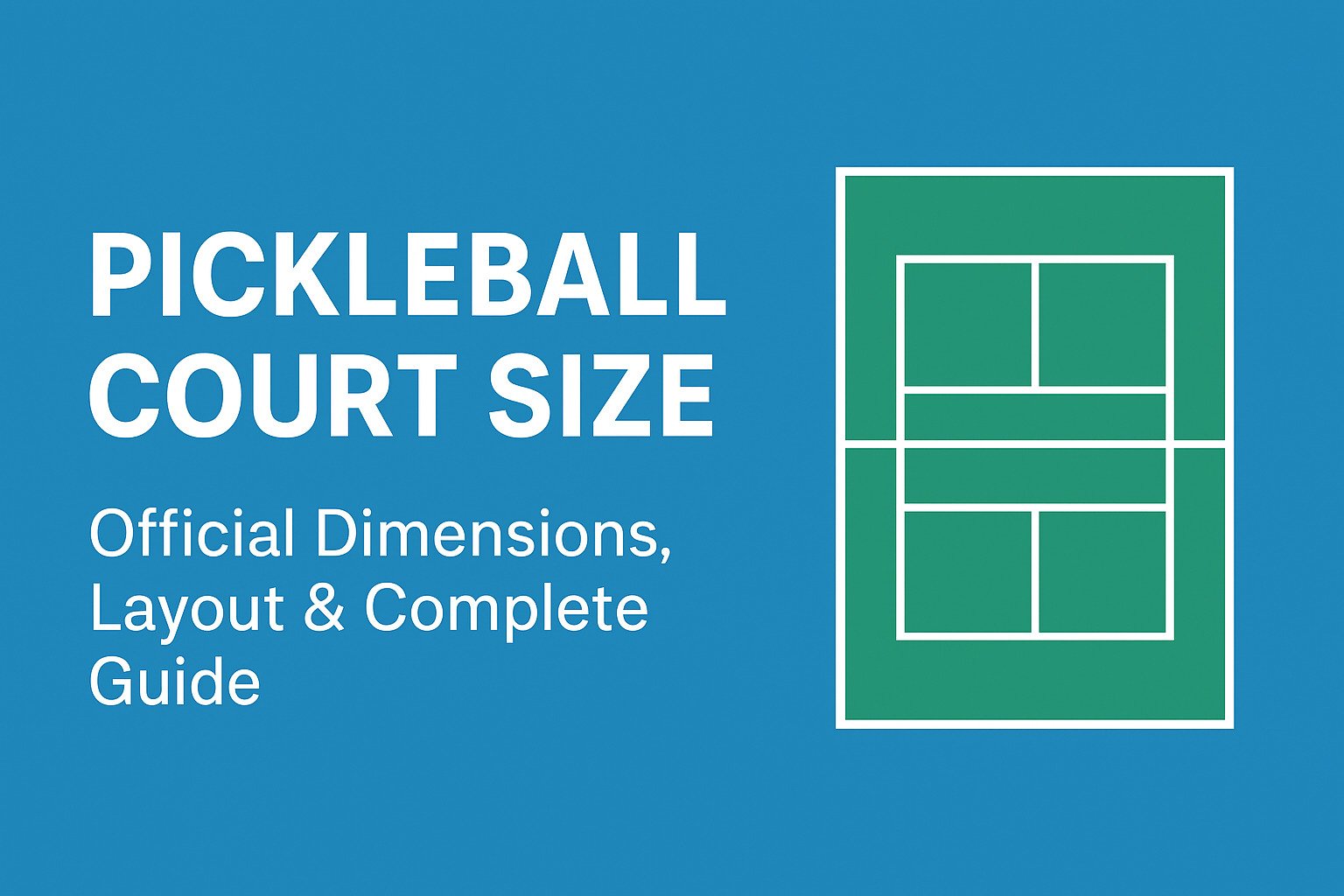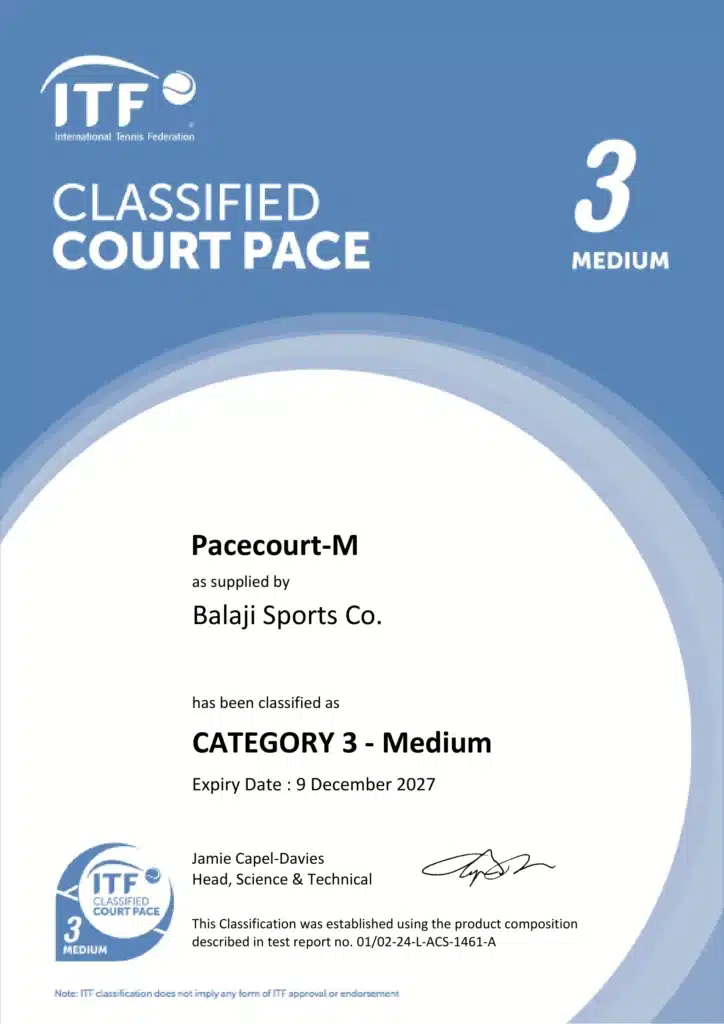
Pickleball has become one of the fastest-growing sports in the world, loved for its simplicity, fast-paced action, and accessibility for all age groups. Whether you want to build a dedicated pickleball court, convert an existing space, or simply understand the official dimensions, knowing the pickleball court size is essential.
This complete guide explains the official court dimensions, layout, zones, net measurements, markings, and space requirements for indoor and outdoor courts. You’ll also find diagrams (explained in words), court variations, and multi-court layouts.
Official Pickleball Court Size (Singles & Doubles)
The official pickleball court size is 20 feet wide and 44 feet long for both singles and doubles.
Unlike tennis and badminton, where court sizes differ for singles and doubles, pickleball uses the same court size for all formats.
Official Pickleball Court Dimensions
| Section | Measurement |
|---|---|
| Total Court Size | 20 ft x 44 ft (6.10 m x 13.41 m) |
| Non-Volley Zone (Kitchen) | 7 ft from the net on both sides |
| Service Areas | 10 ft each |
| Total Playing Area | Minimum 30 ft x 60 ft (recommended 34 ft x 64 ft) |
The playing surface area (30 ft x 60 ft) ensures players have enough room beyond the boundary lines for safe movement.
Court Zones Explained
A pickleball court includes several important zones. Understanding them ensures proper layout and rule-friendly construction.
a) Non-Volley Zone (The Kitchen)
- Size: 7 ft deep, stretched across the entire width (20 ft).
- Players cannot volley (hit the ball in the air) inside this zone.
- One of the most strategic areas of the court.
b) Service Areas
Each side of the court has two service courts:
| Service Area | Size |
|---|---|
| Right Service Box | 10 ft x 15 ft |
| Left Service Box | 10 ft x 15 ft |
These areas are defined by:
- Centerline
- Sideline
- Baseline
- Kitchen line (Non-volley zone line)
c) Baselines & Sidelines
- Baselines: The back boundary lines (20 ft wide)
- Sidelines: The long edges of the court (44 ft long)
d) Centerline
- Divides the left and right service courts.
- Extends from the kitchen line to the baseline.
Minimum Space Requirements
The court itself is 20×44 ft, but the recommended playing area is larger to ensure safety and comfort.
Minimum Required Space
- 30 ft x 60 ft
Recommended Tournament Space
- 34 ft x 64 ft
This additional space includes extra area behind baselines and sidelines.
Indoor vs Outdoor Pickleball Court Size
The court size remains the same indoors and outdoors.
The differences lie in:
Indoor Court Considerations
- Minimum recommended ceiling height: 18–20 ft
- Need for consistent lighting (at least 200–300 lux)
- Smooth acrylic or PU flooring preferred
Outdoor Court Considerations
- Acrylic or synthetic cushioned surfaces
- Proper slope: 1% for drainage
- UV-resistant paints and coatings
- Wind and sun orientation (ideal north–south layout)
Pickleball Court Layout

A pickleball court has a simple yet highly strategic layout. Although it appears similar to a smaller tennis court, its lines, zones, and measurements are unique. Understanding the layout is essential for proper construction, marking, and competitive gameplay.
Below is a complete breakdown of the pickleball court layout, described clearly and visually in words.
1. Overall Court Shape
A pickleball court is a rectangular playing surface measuring 20 feet wide and 44 feet long.
This includes all play areas used for singles and doubles.
2. The Net Placement
The court is divided in half by a net that stretches across the full 20 ft width.
Net Height Requirements
- 34 inches at the center
- 36 inches at the posts
The slight dip in the center helps improve ball trajectory and gameplay balance.
3. The Non-Volley Zone (Kitchen)
One of the most iconic parts of the pickleball layout is the Non-Volley Zone (NVZ), commonly called the kitchen.
Kitchen Size
- Extends 7 feet from the net on both sides
- Covers the entire 20-foot width
Purpose
Players cannot volley (hit the ball without it bouncing) inside this zone.
4. The Service Courts
The area behind the kitchen is divided into two equal service areas:
Left Service Court
- Located on the left side of the centerline
- Used for left-side serves
Right Service Court
- Located on the right side of the centerline
- All serves begin from this side
Service Court Size
- Each service box: 10 ft x 15 ft
These two service courts are divided by a centerline, which runs straight from the kitchen line to the baseline.
5. Baselines and Sidelines
These are the outer boundary lines of the court.
Baselines
- The back lines of the court
- Length: 20 feet
Sidelines
- The side boundary lines
- Length: 44 feet
Players must serve from behind the baseline.
6. Line Width and Marking Rules
All lines on a pickleball court must follow specific standards.
Standard Line Width
- All court lines should be 2 inches wide
Line Color
- Must contrast with the court surface
- Common combos:
- White lines on a blue or green court
- Yellow lines on darker surfaces
Marking Guidelines
- Lines must be crisp and even
- No slippery or glossy paint
- Acrylic line paint is recommended
7. Total Playing Area Beyond the Court Lines
While the official court is 20 × 44 ft, players need additional space to move safely.
Minimum Play Area Requirement
- 30 ft x 60 ft
Recommended Tournament Area
- 34 ft x 64 ft
This extra space prevents injuries and allows comfortable movement during rallies.
8. Ideal Orientation for Outdoor Layouts
For outdoor pickleball courts:
Best Sun Orientation
- North–South alignment
This ensures players aren’t looking directly into the sun during morning or evening play.
Wind Consideration
- Use windbreaks
- Fencing height typically: 10–12 ft
Net Dimensions
The pickleball net is lower than a tennis net.
Official Pickleball Net Size
| Specification | Measurement |
|---|---|
| Net Width | 22 ft |
| Net Height (at center) | 34 inches |
| Net Height (at posts) | 36 inches |
Pickleball Court Surface Requirements
The playing surface significantly affects performance.
Recommended Surface Types
- Acrylic sports flooring (most popular)
- PU flooring
- Synthetic cushioned flooring
- Concrete base with acrylic top coats
Ideal Surface Properties
- Consistent bounce
- Slip-resistant texture
- Proper cushioning
- UV resistance (outdoor)
- Non-glare finish
Line Markings & Colors
Official Line Width
- All lines must be 2 inches wide
- Contrasting color against the surface
Marking Recommendations
- Use high-quality acrylic line paint
- Avoid slippery gloss paints
- Recommended colors:
- White or yellow lines
- Blue or green courts for contrast
Multi-Court Layouts (2, 4, 6 Courts)
If you’re creating multiple pickleball courts for clubs, schools, or tournaments, spacing is essential.
2-Court Layout
- Total recommended area: 64 ft x 60 ft
4-Court Layout
- Total recommended area: 128 ft x 60 ft
6-Court Layout
- Total recommended area: 128 ft x 90 ft
Courts can be placed side-by-side or lengthwise depending on available space.
Converting Existing Sports Courts into Pickleball Courts
Many facility owners repurpose existing courts.
Convert a Tennis Court
- One tennis court can accommodate:
- 4 pickleball courts comfortably
- Or 2 courts with wide spacing
- Requires new line markings
- Install portable or fixed pickleball nets
Convert a Badminton Court
- A badminton court (20×44 ft) is exactly the size of a pickleball court
- Only line color adjustments required
- Net height needs modification
Convert a Volleyball Court
- Volleyball courts offer plenty of space
- Easily fits multiple pickleball courts
Cost of Building a Pickleball Court
The cost varies depending on surface choice and location.
Estimated Cost Breakdown
- Base Construction: ₹1,50,000 – ₹3,00,000
- Acrylic System Layers: ₹1,50,000 – ₹3,00,000
- Net System: ₹10,000 – ₹40,000
- Lighting (optional): ₹1,00,000 – ₹2,50,000
Total Estimated Cost:
₹3,00,000 – ₹8,00,000 per court
Common Mistakes When Estimating Court Size

- Confusing playing area with total area needed
- Incorrect kitchen size (must be 7 ft)
- Using slippery or wrong paint
- Not maintaining proper net height
- Insufficient space around the court
- Poor surface drainage for outdoor courts
Conclusion
Understanding the pickleball court size and layout is the first step in building a high-quality, tournament-ready court. Whether you’re setting up an indoor or outdoor facility, the official dimensions ensure uniform gameplay and safety.
If you are planning to build a pickleball court, consult professional court builders for accurate measurements, high-quality flooring, and long-lasting construction.



